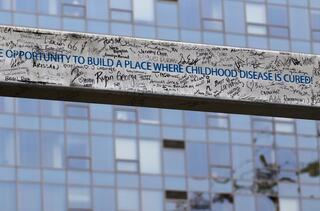Building a High-Performing Life Science Team

As career builders, few things faze Lease Crutcher Lewis’ life science team. Architectural concrete, cGMP spaces, below-grade research suites with highly sensitive vibration requirements, interstitial floors packed with enough MEP infrastructure to service a small village—we’ve built that.
At the same time, we acknowledge that life science projects are tough. From coordinating lab benches and equipment with MEP and lab gasses, to specialty water and waste systems, to building clean rooms inside operating facilities, each project comes with its own unique set of challenges.
That makes you wonder: what ingredients make such complex projects successful? More often than not, it starts with having highly fulfilled and aligned teams.
As career builders, few things faze Lease Crutcher Lewis’ life science team. Architectural concrete, cGMP spaces, below-grade research suites with highly sensitive vibration requirements, interstitial floors packed with enough MEP infrastructure to service a small village—we’ve built that.
At the same time, we acknowledge that life science projects are tough. From coordinating lab benches and equipment with MEP and lab gasses, to specialty water and waste systems, to building clean rooms inside operating facilities, each project comes with its own unique set of challenges.
That makes you wonder: what ingredients make such complex projects successful? More often than not, it starts with having highly fulfilled and aligned teams.
Getting buy-in
Before embarking on Building Cure for Seattle Children’s Research Institute, the team authored a project charter in partnership with our clients. We wanted to connect our work to the mission that the building would serve. This was more than just a set of floors and columns, and we wanted to make sure everyone on the team from our CEO to a carpenter apprentice knew that they were part of the bigger picture.
The team augmented that charter with periodic morning-huddle visits from Seattle Children’s doctors and researchers. It was a constant reminder of who would inhabit the building, and whose world-altering discoveries and therapies the team was ultimately supporting.
“The whole field team there, electricians and everyone, would huddle during the visits,” says Annaliza Mariscal, a senior project engineer on Building Cure. “They were really cool moments!”
The visits and the project charter forged a strong sense of purpose on site, helping the team overcome the day-to-day challenges inherent to any complex project.
For Catherine Lane, a Lewis life science project manager, having a passion for a clients’ mission isn’t just a nice-to-have attribute, she says. It’s a non-negotiable quality when she considers how to staff her projects.
Lewis superintendent Shane Weller started working on-site at Fred Hutchinson Cancer Center more than 20 years ago and has opted to remain there ever since. His focus has been delivering biotech labs and production projects in occupied facilities, scopes that require “invisible” work that’s completed safely and efficiently.
“I feel that this work out here is more than construction,” he says. “It’s a higher purpose.”

Seattle Children’s Building Cure project members affirmed their support by signing a steel beam, which included the project charter.
Chemistry that endures
The glue that binds teams together is chemistry. It’s hard to distill, but you know it when you see it. And teams with strong chemistry perform better.
Teams with chemistry also have fun together. On the surface, fun may appear trivial. But fun in both formal and informal settings is a good indicator of how readily team members will participate in the creative process, and how they’ll stick together when things get tough.
Teams with good chemistry can channel conflict into creative solutions because they operate with the assumption that teammates are coming from a place of good intent. This perspective helps teams reframe the issue, really listen to alternate opinions, and move toward constructive solutions that are the best answer for the project, not someone’s ego. This is magnified when an entire project team has chemistry and trust. Company lines start to blur and the desire for collective project success becomes infectious.
In the best cases, the connections made together on the job extend outside of work. True friendships are built to last through thick and thin. We have more than one recent example where employees working closely with an owner, designer, or sub partner have forged such a close bond that they’ve since travelled the world together. There are some relatives I wouldn’t do that with!
Diverse teams
Diverse teams that bring varied backgrounds, thought, industry experience, and leadership styles to the job site drive innovation, which in turn produces better solutions and financial outcomes. These differences empower teammates to learn from one another, generate novel ideas, and account for a broader range of variables during the planning stage.
“Asking questions and encouraging everyone to buy into the project encourages diversity of thought,” says superintendent Scott Woolworth.
But to ensure that diverse teams can maximize their potential, each member needs to feel empowered to have a voice on the project—not just the team leader.
“It’s critical to create psychologically safe spaces where people feel comfortable sharing better ideas,” Annaliza Mariscal says.
And with that freedom comes the ability for team members to self-actualize in the workplace, to be their authentic themselves, and put their passions on display. When Catherine Lane first joined the Lewis team in 2019, she went home and said of her coworkers that “Everyone’s a nerd, too! It’s awesome!’”
Ed Barajas, a senior MEP specialist at Lewis, has added a vanity license plate to his car to reflect his standing at work. It reads “MEPGURU,” a role he relishes and a pride in oneself that we love to support.
Coriann Presser is Lease Crutcher Lewis’s director of operations for life sciences. Bringing two decades of experience in the local market, she leads teams on some of Lewis’ most technically complex and high-sensitivity projects.